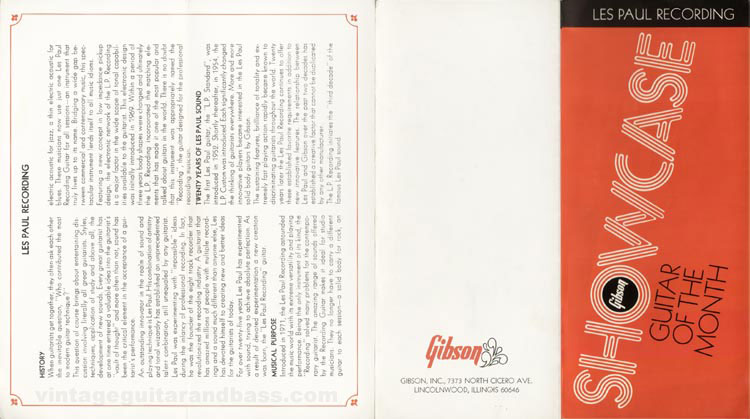
In 1972 Gibson launched a flyer devoted to the Les Paul Recording - The Gibson Les Paul Recording Guitar of the Month Showcase, reproduced here in two parts
The Gibson Les Paul Recording Showcase Part 1 shows a detailed image of the guitar with key parts labelled and described.

HISTORY
When guitarists get together, they often ask each other the inevitable question, "Who contributed the most to modern guitar technique?"
This question of course brings about entertaining discussion involving literally all great guitarists. Styles, techniques, application of study and above all, the development of new sounds. Every great guitarist has at one time entered a valuable idea into the guitarist's "vault of thought" and more often than not, sound has been the critical element in the acceptance of a guitarist's performance.
An outstanding innovator in the realm of sound and playing technique is Les Paul. His combination of artistry and tonal wizardry has established an unprecedented talent combination, still unequalled by any guitarist.
Les Paul was experimenting with "impossible ideas during the infancy of professional recording. In fact, he was the founder of the eight track recorder that revolutionized the recording industry. A guitarist that has amazed millions of people with multiple recordings and a sound much different than anyone else, Les has devoted himself to creating new and better ideas for the guitarists of today.
For over twenty-five years Les Paul has experimented with sound, trying to achieve absolute perfection. As a result of devoted experimentation a new creation was born, the "Les Paul Recording' guitar.
MUSICAL PURPOSE
Introduced in 1971, the Les Paul Recording astounded the music world with its extreme versatility and playing performance. Being the only instrument of its kind, the "Recording" solved many problems for the contemporary guitarist. The amazing range of sounds offered by the Recording Guitar makes it ideal for studio musicians. They no longer have to carry a different guitar to each session-a solid body for rock, an electric acoustic for jazz, a thin electric acoustic for blues. These musicians now use just one Les Paul Recording Guitar for all sessions-an instrument that truly lives up to its name. Bridging a wide gap between commercial and contemporary music, this spectacular instrument lends itself to all music idioms.
Featuring a new concept in low impedance pickup design, the electronic network of the L.P. Recording is a major factor in the wide scope of tonal capabilities available to the guitarist. This electronic design was initially introduced in 1969. Within a period of three years body shapes were changed and ultimately the L.P. Recording incorporated the matching elements that has made it one of the most popular and talked about guitars in the world. There is no doubt that this instrument was appropriately named the "Recording ', the guitar designed for the professional recording musician.
TWENTY YEARS OF LES PAUL SOUND
The first Les Paul guitar, the "L.P. Standard", was introduced in 1952. Shortly thereafter, in 1954, the L.P. Custom was introduced. Each significantly changed the thinking of guitarists everywhere. More and more innovative players became interested in the Les Paul solid body guitars by Gibson.
The sustaining features, brilliance of tonality and extremely fast playing action rapidly became known to discriminating guitarists throughout the world. Twenty years later the Les Paul Recording continues to offer these established favorite requirements in addition to new innovative features. The relationship between Les Paul and Gibson over the past two decades has established a creative factor that cannot be duplicated by any other manufacturer.
The L.P. Recording initiates the "third decade" of the famous Les Paul sound.
Other brochures in the 1972 guitar of the month showcase series
$3649
$4000
$3600
$195
$4495
C $3800